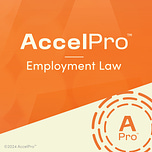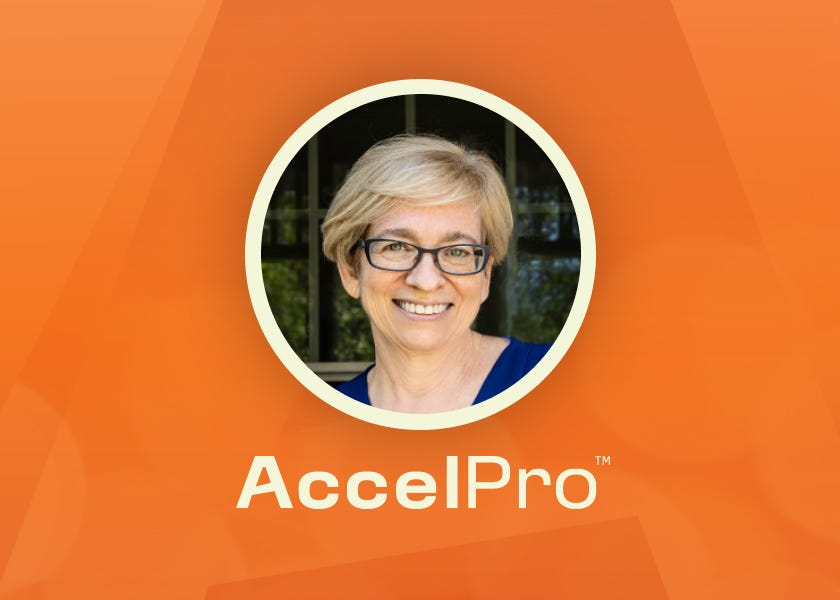We hope you’re finding value in our weekly expert interviews and series of events. Your engagement and feedback shape the topics we cover and the career products we offer. Sign up now, and your annual membership will include a free trial and a discount of more than 40%.
Welcome to AccelPro Employment Law, where we provide expert interviews and coaching to accelerate your professional development. Today, we are featuring Part I of a discussion with Chai Feldblum about her career-spanning work with the Americans with Disabilities Act (ADA) and LGBTQ+ issues.
Feldblum served as a Commissioner at the Equal Employment Opportunity Commission (EEOC) for 10 years and is now Vice Chairperson of the AbilityOne Commission and a workplace consultant. In the words of Feldblum, “To achieve any lasting change in social justice, three variables must operate in synergistic fashion: law, policies and practice, and social norms.”
NOTE: Listen to Part II of the AccelPro conversation with Chai Feldblum.
AccelPro’s expert interviews and coaching accelerate your professional development. Join AccelPro Employment Law now for a free trial of everything we offer to members.
Interview References:
Chai Feldblum’s profile.
2:12 | U.S. AbilityOne Commission.
3:28 | Employment Non-Discrimination Act, S.815 (2013).
3:28 | The Americans with Disabilities Act Amendments Act of 2008, PL 110-325 (S 3406), 42 USCA § 12101 note (2008). US Equal Employment Opportunity Commission.
4:21 | Title VII of the Civil Rights Act of 1964, § 7, 42 U.S.C. § 2000e et seq (1964). US Equal Employment Opportunity Commission.
4:48 | Feldblum, Chai. Law, Policies in Practice and Social Norms: Coverage of Transgender Individuals under Sex Discrimination Law. 14 Wayne State Law Review 1. (2013).
8:14 | The Americans with Disabilities Act, (1990). U.S. Department of Justice, Civil Rights Division.
14:21 | Feldblum, Chai. Gender Equity in the 21st Century: Keynote Address. (2015). Richmond Public Interest Law Review (PILR). Volume 18, Issue 4, Article 3.
17:02 | Examples of Court Decisions Supporting Coverage of LGBT-Related Discrimination Under Title VII. US Equal Employment Opportunity Commission.
17:31 | Hoffman, Sharona; Miller, Paul Steven; Feldblum, Chai; and Stein, Michael Ashley. The Definition of Disability in the Americans with Disabilities Act: Its Successes and Shortcomings: Proceedings of the 2005 Annual Meeting, Association of American Law Schools Sections on Employment Discrimination Law; Labor Relations and Employment Law; and Law, Medicine and Health Care. (2005). College of William & Mary Law School. Faculty Publications.
18:18 | Bostock v. Clayton County, Georgia, No. 17–1618 (2020). Supreme Court of the United States.
TRANSCRIPT
I. THE SYNERGY OF LAW, POLICIES AND SOCIAL NORMS
Matt Crossman, Host: Let’s start with your bio. You clerked for Supreme Court Justice Harry Blackmun. You served as a Commissioner at the EEOC for 10 years, and you helped craft the Americans with Disabilities Act and legislation protecting LGBTQ+ rights in the workplace.
And now you are the Vice Chairperson of the AbilityOne Commission and a workplace consultant. What is the AbilityOne Commission and what do you do for them?
Chai Feldblum: So the AbilityOne Commission is made up of 15 members of which four are private citizen members representing the interests of people with disabilities. The goal of the AbilityOne Commission is to leverage the power of government contracting to encourage the hiring of people who are blind and have significant disabilities.
So it’s a very good concept—let’s leverage the power of government contracting. There’s about $4 billion of government contracts that run through the program now. But we are in the midst of modernizing the program so that it aligns more with current disability rights principles, especially those of integration and upward mobility. So there’s work that needs to be done in the agency, which to be honest, is why I joined it.
MC: I’d like to try and synthesize your work in the LGBTQ+ and disability worlds. You played a crucial role in crafting legislation in both of those areas. What were the goals when you were drawing up those laws and have they been achieved?
CF: Well, the goals are pretty basic, right? It’s basic human rights. Basic human rights means that we all have the opportunity to grow and thrive, live to our fullest potential without the fact that we have some particular characteristic, which other people might have stereotypes or even animus about, holding us back.
The idea of a non-discrimination law is to say you judge the person on their merits. You treat them as equals. So if they’re not similarly situated in the first place, you might need to, for example, give a reasonable accommodation. But you treat folks on their merits, and you do not discriminate against them.
And we were very lucky to have the 1964 Civil Rights Act establish this rule for characteristics such as race and sex, religion, national origin. But it didn’t establish it for people with disabilities or for people who are LGBTQ+. So that was the goal of those laws.
MC: A quote I’m going to read comes from the Wayne State Law Review. “To achieve any lasting change in social justice, three variables must operate in synergistic fashion: law, policies and practice, and social norms.” Broadly speaking, how do those three operate in synergistic fashion?
CF: The goal is to treat people as equals, to treat them in a way that lets people operate to their fullest capacity. So that’s a social-justice goal. Well, how do we achieve that?
Lots of times people just think about law, right? Like you asked, what was your goal in helping to draft and pass those laws? The goal was to stop discrimination. Passing a law is very important as an element. And law of course includes not just the words—the piece of legislation that a legislature passed—but also how it’s interpreted by the agencies, how it’s interpreted by the courts. All of that constitutes law.
But once you have a law, the question is, how is it absorbed in practice? So let’s take employment law. You can pass the law saying no discrimination on the basis of sex, for example, but how is it really absorbed in policies and practices in an employment setting? And even if you have policies and practices, do people really believe that non-discrimination rules make sense?
Because if they don’t, you can’t police everything. So just taking one example from sex. So in 1964 Congress passed a law that says you can’t discriminate based on sex in employment. The EEOC issued guidance saying that includes a prohibition on sexual harassment, something that the Supreme Court ultimately confirmed, which really made it stronger than the just the agency ruling.
So you have a law that says you can’t engage in sexual harassment, but how is that absorbed in the employment setting? You would need policies against sexual harassment. You would have to explain to people what that meant, what the expectations were. But even if you had that, you need to change the social norm. It has to be that in that culture it’s not okay for someone to be sexually harassed.
And in a way, we had the prohibition against sexual harassment for years. We’ve had policies and practices, not all the way through in every company, but in a lot of them. But then the Me-Too movement just shifted it in terms of changing social norms. And the point is, it works synergistically. You often don’t get the law passed or the agency ruling until there’s some social norm change.
Sometimes the social norm change will make some policies and practices be put in place by employers even before there’s a law, so they operate synergistically. You have to keep your eyes on the prize of all three.
—
II. COMPARING AND CONTRASTING DISABILITY AND LGBTQ+
MC: I thought it would be helpful to compare and contrast where we are on the two issues that we’re discussing—disability and LGBTQ+.
CF: On disability, obviously we have the Americans with Disabilities Act, and most states have their own laws as well. So what we have in terms of disability in the law is a statement that you can’t discriminate based on disability. And it says that part of non-discrimination is providing reasonable accommodations.
It’s not that you’re treating people equally in the sense that you’re treating them the same. You’re treating them as equals. So if they’re not similarly situated in the first place—for example, we build our buildings with steps, and if someone uses a wheelchair, they can’t go up those steps. To treat them as an equal, you have to do a reasonable accommodation. So that’s what the law says.
A lot of companies have policies and procedures in place for non-discrimination on the basis of disability, but there’s so much teaching that needs to happen. HR execs and employment lawyers: You would get such an advantage from number one, having a very simple, easy to understand, reasonable accommodation policy.
I just wrote one recently for a client without legalese. You want that. And then you want good training. So part of those policies includes good training. And then the social norms—people’s assumptions about the capability of people with disabilities to perform—that has to change.
Whether it’s someone who’s deaf or blind or uses a wheelchair or someone with significant psychiatric disabilities, you have to change the social norm in order for the hiring manager to hire people with significant disabilities. So those three all operate together.
With LGBTQ, it’s so interesting because that’s an example where the social norms have been changing first.
Think about the gay rights movement. I know it seems like it’s accelerated a lot, but I’ve been working in that movement since I was 23. and the social norms in a sense changed first—the culture accepting gay people.
Then a lot of employers voluntarily put in policies prohibiting discrimination against their lesbian and gay employees, and then as we came to understand transgender folks as part of the community, adding discrimination against transgender folks.
And I know a lot of people stumble like, LGBTQ+, and they feel like it’s an alphabet soup and it makes no difference. It makes a difference. Because for this young generation, as I learned, they consider themselves Q—queer, and then there are others who say, there are other pieces, so LGBTQ+.
After the voluntary work, law almost came last, at least on the federal level. I worked with many others to draft the Employment Non-Discrimination Act, which initially just prohibited discrimination based on sexual orientation, then added gender identity, which again, I was very involved in making that change.
That was a federal law that as most people know, has not even ever passed and yet remember about law—law can change by a court decision. So the Supreme Court’s decision, following decisions from the EEOC, which was really important in terms of changing the landscape, has now ruled sex discrimination in employment includes sexual orientation and gender identity.
You cannot differentiate. You can’t unpack how sex plays a role in discrimination based on sexual orientation and gender identity. So now the law has caught up, and it is illegal in employment under Title VII to discriminate on the basis of sexual orientation or gender identity. That’s a movement that includes these three variables.
—
III. THE IMPORTANCE OF PRECISE LANGUAGE
MC: I wanted to ask you something very specific on social norms and how they change. As we were preparing for this interview, we traded emails. I quoted an article that you wrote, and you wrote back cringing at some language you used, which I think we could agree was socially acceptable at the time. How can we give each other grace in such circumstances while at the same time recognizing that change needs to be made?
CF: So I love how you frame that question. It’s about giving grace to those who are not using quote unquote the right terms, but still doing the education so they understand why a different term is what matters to the community now. So another piece in that article that I didn’t cringe at, but it’s not something I write anymore, is saying “we need to focus on ability rather than disability.”
Well, of course, as I said before, you’ve have to judge people on their merits, not have stereotypes and assumptions. So of course you’re judging them on their ability. But that type of phrase makes it sound as if there’s something wrong about disability. And at this point in the community, we as folks with disabilities, just use the term disability.
We don’t do ability. We don’t do differently abled. It’s like, yeah, we have a disability. That’s it. It’s part of us. It’s not all of us, but it is part of us. So I think instead of people feeling like there’s something wrong when someone uses a term that you don’t use anymore and sort of getting on them, it’s about explaining why.
There’s a reason to say LGBTQ+, and if sometimes you get it mixed up, at least you’re trying.
MC: I’ve been fascinated that across your work, there’s a lot of careful dissection of language and how we use it. I read a keynote address that you gave, and you had a passage about Title VII and how the EEOC and the courts, “found it hard to accept the words of the law at face value.”
The example that you used was help wanted ads. If you put “for whites” in a help wanted ad, that was deemed discriminatory. But if you put “for men” or “for women,” those were not deemed sexist. They would be now. I wonder if there’s an example in today’s world where there’s a plain language protection that courts don’t really seem to be protecting.
CF: Let’s go back to the example—print newspapers had help wanted ads, and they used to be divided for whites and for blacks and for men and for women in terms of jobs. And in 1964, the law passes, the EEOC has now issued regulations, and in their regulations they said, “oh, that’s discriminatory to say, for whites, for blacks,” right?
But they didn’t find it discriminatory to have a column that was just for men or for women for different jobs. Because they said, “Oh no, men and women want different jobs. So of course it’s helpful to them if you separate it out.”
Then there were women who said, “Excuse me, it says you can’t discriminate based on sex. That means you can’t have help wanted ads that are segregated by sex.” And the EEOC changed pretty quickly.
The example I would use for now is the one that the Supreme Court actually answered for us, but people are still not quite getting it. And that was protecting lesbian, gay and trans folks under the plain word sex.
I used to say about this, that cultural logic had to change before legal logic caught up. So it’s obvious that sex discrimination would cover, let’s say, a lesbian who had a picture of her wife on her desk and she got fired, and her colleague, who’s a guy who has a picture of his wife on the desk, doesn’t get fired.
So obviously that’s discrimination based on sex, but culturally, people couldn’t assume that law would prohibit discrimination against gay people. Just like in 1964, they couldn’t assume that sex meant you couldn’t have sex segregated job advertisements.
Now again, what’s interesting to me is that even though the Supreme Court has said, “Hey, sex includes sexual orientation and gender identity,” there are lots of people who still think that we need to pass some other law to get that protection.
I think we’ll find out others as we go, things that we don’t understand now because our cultural norm hasn’t changed.
MC: The topic of language again came up when you wrote about the use of particular words, disability being one of them, transgender being one of them, making that word more real. And you wrote this, “if the word gets on the flier about employee rights, that is posted in the coffee room, you get gender identity on people’s minds.”
That sounds like valuable insight for HR directors and employment attorneys. Explain how that works—that sounds like the policy interacting with social norm?
CF: Yes—and also interacting with law. Because the EEOC says very clearly to implement the civil rights laws, you need to have a poster in your break rooms saying, “Hey, employees, know that you have protection if you experience discrimination on any of these basis.”
So it would have been good, let’s say, after the Supreme Court decided the case in Bostock that says sex includes sexual orientation and gender identity, if every one of those posters had been amended to say sex, sexual orientation, gender identity. And again, because a lot of people don’t read posters, you would think that in today’s world it would be something that would go in an email to folks.
It makes a difference to have something said explicitly.
NOTE: Listen to Part II of the AccelPro conversation with Chai Feldblum.
This AccelPro audio transcript has been edited and organized for clarity. This interview was recorded on August 14, 2023.
AccelPro’s interviews and products accelerate your professional development. Our mission is to improve your day-to-day job performance and make your career goals achievable.
Send your comments and career questions to questions@joinaccelpro.com. You can also call us at 614-642-2235.
If your colleagues in any sector of the employment law field might be interested, please let them know about AccelPro. As our community grows, it grows more useful for its members.












